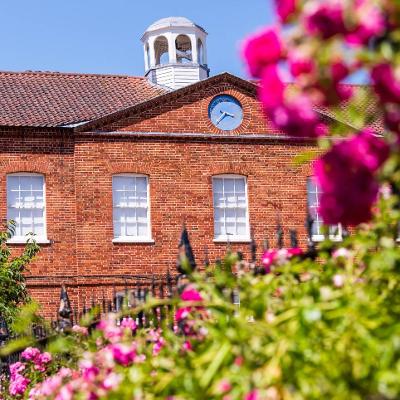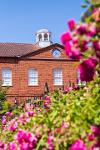Gardens and grounds at Gressenhall Farm and Workhouse
Gressenhall Farm and Workhouse is set in 50 acres of beautiful Norfolk countryside

Cherry Tree Cottage garden

Meander through Cherry Tree Cottage garden and admire the towering hollyhocks, glorious roses and fragrant lavender. Discover fruit trees nestled next to Cherry Tree Cottage and an array of fruit and vegetables growing in the organic vegetable patch. This garden has been created and cared for by our dedicated volunteer gardeners.
Historic orchard
Planted on the workhouse burial ground, the historic orchard is home to various varieties of heritage apple trees.
Centenary wood

Past the orchard, you can take a wander through the woods! Find some minibeasts, play hide and seek and go on a scavenger hunt. What will you discover?
Wildlife garden
Featuring an array of different habitats, our wildlife garden is a haven for amphibians, insects and birds. Come in, take a seat, and enjoy the peaceful beauty of this idyllic spot.
Farmhouse garden
Down on Gressenhall Farm, the farmhouse garden and organic vegetable patch is another area cared for by our volunteers.
Here you can find a beautiful array of flowers and delicious fruit and vegetables.
Wildlife walk
Discover our wonderful river landscape, spot beautiful wildlife, and immerse yourself in stunning wildflowers on our circular farm walk. There's a shortcut too if you have little legs with you!
The history of Gressenhall's grounds
The Guardian's Minute books mention that Gressenhall's gardens and grounds were used for producing provisions for the Union Workhouse including 'four combs of white peas with an estimated value of £5' and '16 sacks of potatoes valued at £5 and 12s' in 1848, worth over £800 today.
However, not all the land was used for producing food to eat. In 1837, 'Upon the recommendation of the visiting committee it was resolved that the wasteland in front and either side of the entrance gate be laid out in broad walks for the recreation of the aged inmates and in gardens for the employment of the boys'. The minutes also record that the aged men were employed in the garden, under the directions of the visiting committee.
We also know that there was an area of the main courtyard was laid out with a garden by at least the start of the early 20th century.





